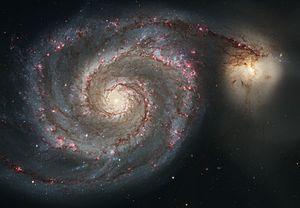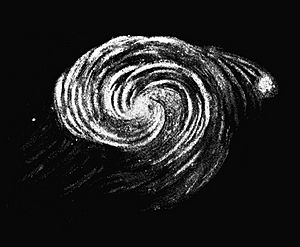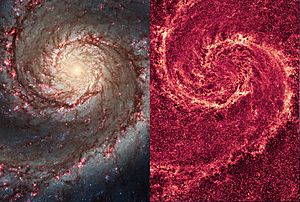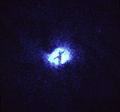Whirlpool Galaxy facts for kids
Quick facts for kids Whirlpool Galaxy |
|
|---|---|

Whirlpool Galaxy (M51A or NGC 5194). The smaller object in the upper right is M51B or NGC 5195.
|
|
| Observation data (J2000 epoch) | |
| Constellation | Canes Venatici |
| Right ascension | 13h 29m 52.7s |
| Declination | +47° 11′ 43″ |
| Redshift | 0.001544 |
| Distance | 23 Mly (7.2 Mpc) (NED) 31 Mly (9.5 Mpc) (NASA) |
| Type | SA(s)bc pec |
| Apparent dimensions (V) | 11′.2 × 6′.9 |
| Apparent magnitude (V) | 8.4 |
| Notable features | Interacting with NGC 5195 |
| Other designations | |
| Question Mark Galaxy, Rosse's Galaxy, M51a, NGC 5194, UGC 8493, PGC 47404, VV 001a, VV 403, Arp 85, GC 3572 | |
| See also: Galaxy, List of galaxies | |
The Whirlpool Galaxy, also known as Messier 51a (M51a) or NGC 5194, is a stunning spiral galaxy that is interacting with a smaller galaxy next to it. It has beautiful, clear spiral arms, which is why it's called a "grand-design" spiral galaxy.
This galaxy is found in the constellation called Canes Venatici. It was the very first galaxy ever identified as having a spiral shape. The Whirlpool Galaxy is about 23 to 31 million light-years away from Earth. It measures about 77,000 light-years across.
You can easily see the Whirlpool Galaxy and its companion, NGC 5195, even with binoculars if you have a dark sky. Many amateur astronomers enjoy observing them. Professional astronomers also study these two galaxies a lot. They want to understand how galaxies are structured and how they interact with each other.
Contents
Discovery of the Whirlpool Galaxy

The Whirlpool Galaxy was first discovered on October 13, 1773. It was found by a French astronomer named Charles Messier. He was looking for objects that might be mistaken for comets. He added it to his list of objects as M51.
Later, in 1781, another astronomer named Pierre Méchain discovered the smaller galaxy next to it, NGC 5195. For a long time, scientists weren't sure if these two galaxies were actually interacting or just passing by each other.
A big discovery happened in 1845. An Irish astronomer named William Parsons, 3rd Earl of Rosse, used a very large telescope. He saw that M51 had a clear spiral shape. This was the first time anyone realized a "nebula" (which is what galaxies were called back then) had spiral arms.
It wasn't until Edwin Hubble's work that we understood these "spiral nebulae" were actually separate galaxies. He proved they were incredibly far away, much too far to be inside our own Milky Way.
Later, with the invention of radio astronomy, scientists could clearly see that the Whirlpool Galaxy and its companion were indeed interacting. Sometimes, the name M51 refers to both galaxies together. In that case, the main galaxy is M51a (NGC 5194), and its companion is M51b (NGC 5195).
How to See the Whirlpool Galaxy
To find M51, look for the constellation Canes Venatici. A good starting point is the easternmost star of the Big Dipper, called Eta Ursae Majoris. From there, go about 3.5 degrees southwest.
Because of its position in the sky, M51 never sets for observers in many northern areas. This means you can see it high in the sky from November to May.
You can see M51 with binoculars if the sky is very dark. With a small telescope (about 100 mm), you can see the basic shape of M51 and its companion. If you use a medium-sized telescope (150 mm) under dark skies, you might even start to see the spiral structure.
With larger telescopes (over 300 mm), the spiral arms become much clearer. You can also see bright areas where new stars are forming. These telescopes also show that M51 is connected to its companion, M51B.
To truly see the full beauty and details of the Whirlpool Galaxy, you need long-exposure photographs. These pictures show a much larger cloud of gas and dust than what you can see with your eyes. In 2005, the Hubble Space Telescope took an amazing, very detailed picture of M51. This image really highlights the galaxy's spiral arms and shows tiny details within them.
Features of the Whirlpool Galaxy
The Whirlpool Galaxy is about 24.3 million light-years away from Earth. It is about 77,000 light-years across. This makes it about 88% the size of our own Milky Way galaxy. Scientists estimate its total mass is about 160 billion times the mass of our Sun. This is about 10% of the Milky Way's mass.
At the very center of the Whirlpool Galaxy, there is a black hole. It was once thought to be surrounded by a ring of dust. Now, scientists believe the dust is partly blocking our view of it. From this active center, two cone-shaped streams of energy extend outwards.
Spiral Arms and Interaction
The Whirlpool Galaxy has two very clear spiral arms that wind around its center in a clockwise direction. These arms are not perfectly shaped; one of them bends quite a bit.
Scientists believe these strong spiral arms were formed because of the close interaction with its companion galaxy, NGC 5195. It's thought that NGC 5195 passed through the main part of M51 about 500 to 600 million years ago. Then, it might have crossed through M51's disk again more recently, about 50 to 100 million years ago. This interaction pulled and shaped the Whirlpool Galaxy into its beautiful spiral form.
Tidal Features from Interaction
The interaction between the Whirlpool Galaxy and NGC 5195 has created some interesting features called "tidal features." These are like long streams of gas and stars pulled away from the galaxies.
The largest of these is called the Northwest plume. It stretches out very far, about 140,000 light-years, from the galaxy's center. This plume is likely made of gas from the Whirlpool Galaxy itself. Nearby, there are two other plumes that look a bit bluer. These are called the Western plumes.
In 2015, scientists found two more tidal features: the "Northeast plume" and the "South plume." Computer models that simulate only one pass of NGC 5195 through the Whirlpool Galaxy can't create these features. This suggests that the companion galaxy must have passed through the Whirlpool Galaxy multiple times to create all these complex structures.
Star Formation in the Galaxy
The central part of M51 is currently forming many new stars. The spiral arms are also very active with star formation. Even the space between the arms shows signs of new stars being born.
The rate at which new stars are forming in M51 is similar to what we see in the Milky Way. Scientists estimate that this high rate of star formation in the Whirlpool Galaxy might continue for another 100 million years or so.
Exploding Stars (Supernovae)
Scientists have seen several supernovae (exploding stars) in the Whirlpool Galaxy:
- In 1994, a supernova called SN 1994I was observed. It was a very bright explosion, reaching a brightness of magnitude 12.91. This type of supernova happens when a very massive star runs out of fuel and collapses.
- In June 2005, another supernova, SN 2005cs, was seen. It reached a brightness of magnitude 14.
- On May 31, 2011, SN 2011dh was discovered. This supernova was very bright, reaching magnitude 12.1. It was unusual because its light looked bluer than most supernovae. Scientists think it came from a yellow supergiant star.
- On January 22, 2019, a "supernova impostor" called AT2019abn was found. This wasn't a true supernova, but a very bright explosion called a luminous red nova. The star that caused it was hidden by a lot of dust.
Possible Planet Outside Our Galaxy
In September 2020, something very exciting was announced! The Chandra X-ray Observatory found a possible exoplanet (a planet outside our solar system) in the Whirlpool Galaxy. It's named M51-ULS-1b.
If this discovery is confirmed, it would be the first planet ever found outside our own Milky Way Galaxy! This candidate planet was found because it passed in front of an X-ray source, causing a dip in its X-ray light. This X-ray source is made of a dead star (either a neutron star or a black hole) and a very large, bright star.
Scientists think this planet might be a bit smaller than Saturn. It would orbit its stars at a distance of several tens of astronomical units.
Companion Galaxy: NGC 5195
NGC 5195 is a smaller galaxy that is interacting with the Whirlpool Galaxy. It is also known as Messier 51b or M51b. Both galaxies are about 31 million light-years away in the constellation Canes Venatici. Together, they form one of the most studied pairs of interacting galaxies in the sky.
Galaxy Group Information
The Whirlpool Galaxy is the brightest galaxy in a small collection of galaxies called the M51 Group. This group also includes the Sunflower Galaxy (M63), NGC 5023, and NGC 5229. This small group might even be part of a larger, stretched-out group that includes other famous galaxies like the M101 Group.
Gallery
-
Supernova impostor AT2019abn, imaged by the Hubble Space Telescope
See also
 In Spanish: Galaxia Remolino para niños
In Spanish: Galaxia Remolino para niños
- List of Messier objects
- List of galaxies
- Messier object
- Messier 101 – another grand-design spiral galaxy
- New General Catalogue
- NGC 5195 – the companion galaxy to NGC 5194








